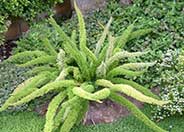
Common name:Myers Asparagus
Botanical name:Asparagus densiflorus 'Myers'
An evergreen groundcover, the 'Myers' also makes an excellent hanging basket plant when larger in size. Its formal looking fronds have an even, spiral arrangement of leaflets. It is damaged by severe frosts, and looks best with at least occasional watering.

Common name:Dusty Miller, Silver Groundsel
Botanical name:Senecio cineraria
The Dusty Miller exhibits growth to 1' or more, with velvet gray leaves that have broad, roundish lobes. Yellow flower heads appear through the middle of the plant during most months of the year. Cut heads back occasionally to encourage bushiness.
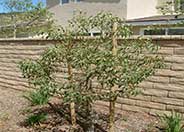
Common name:Bottle Tree, Kurrajong
Botanical name:Brachychiton populneus
This evergreen tree will grow 25'-75' tall and produces white blooms that are magenta on the inside. It is very drought tolerant and does best in full sun.
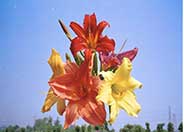
Common name:Daylily (hybrid selection)
Botanical name:Hemerocallis hybrids
These summer-blooming perennials form clumps with large, grass-like leaves. Its showy flowers, resembling lilies, are borne in clusters on stems held well above the foliage. Daylilies can be found in many colors: yellow, orange, red, purple, pink or multi-colored. Hemerocallis does better in well-draining soil and with extra summer water. Hemerocallis are very hardy,with few or none pests/problems.
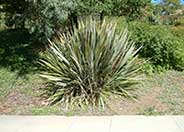
Common name:New Zealand Flax
Botanical name:Phormium tenax
New Zealand Flax is a large, bold plant with stiffly vertical, sword-like, green leaves that arise from its base. It should be grown under full sun for best color. Varieties will offer different growth habits and leaf color.
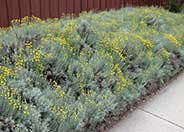
Common name:Lavender Cotton
Botanical name:Santolina chamaecyparissus
This ground cover/small shrub will grow to 3' tall and has small, grayish silver leaves with yellow flowers that bloom in the summer.
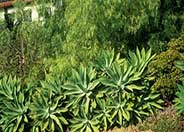
Common name:Fox Tail Agave, Velvet Agave
Botanical name:Agave attenuata
This Agave has a dramatic tropical form. Even light frost can damage its succulent leaves. It is great for containers. In the low desert, partial sun will be best. If it becomes top heavy, simply cut and stick in the ground to root. It is not a fast grower and has light green foliage. It will also die after flowering but pups around the mother will survive. Distinctive with its large rosette of leaves perched on a long curving trunk, it is a native from Mexico.

Common name:Goodwin Creek Gray Lavender
Botanical name:Lavandula 'Goodwin Creek Gray'
Lavandula 'Goodwin Creek Gray' is an evergreen shrub. This dense foliaged plant grows to 2.5'-3' high and 3'-4' wide, with silvery leaves that are toothed at the tips. Deep violet-blue flowers bloom from spring to late fall.
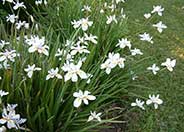
Common name:Butterfly-Iris, Fortnight Lily
Botanical name:Dietes iridioides
This clumping evergreen Iris bears tall, narrow leaves to 30" tall and white flowers marked purple in the center on stalks up to 3' tall. This variety has stiffer, darker foliage than the bicolor form. It requires sun to part shade with little or no summer watering when established.

Common name:Purple Hopseed Bush or Hop Bush
Botanical name:Dodonaea viscosa 'Purpurea'
This fast-growing shrub has an upright, branching habit that reaches a height of 12'-15', with willow-like leaves that are 4" in length. Its foliage is bronzy-green in color, which turns a reddish-purple shade in the fall and winter. It has compact growth and requires full sun for the best results.
| Designer: California Native Garden | Lovely Hillside |
Photographer: GardenSoft |
Soils and Compost:
Physical weed control, including mulching, or hand removal protects the watershed from harmful chemicals.
Water Saving Tip:
Integrated Pest Management:
Drip and other smart irrigation delivers water directly to roots, allowing no excess water for weeds.

